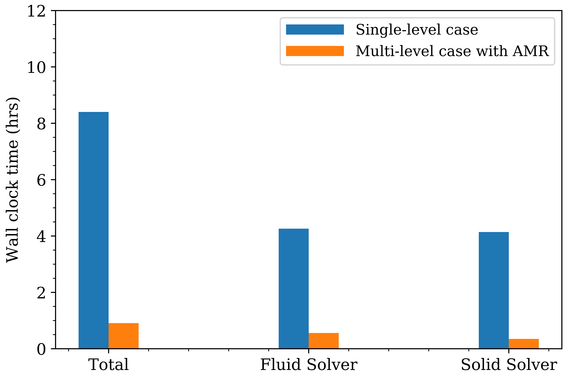Underwater biological flows and biomimetics are fascinating given that life began in the ocean and over 70% of the Earth’s surface is covered in water. They typically involve complex flow phenomena, coupled with strong interaction with highly flexible and deformable bodies.
To address these problems, our research group has been developing advanced fluid-structure interaction algorithms and numerical techniques. The computational algorithm is based on the immersed boundary method in a domain with arbitrarily complex, dynamically deforming bodies, such as aquatic swimmers and bio-inspired robots. The computations can be performed in realistic, oceanic settings. The Adaptive Mesh Refinement (AMR) technique is also incorporated in the fluid structure interaction (FSI) problem. The figure below shows the simulation of 3D swimming fish with four levels of computational grids, in which the grid cells are refined around the fish body to improve the resolution. Also shown is the comparison of wall clock time between the single-level case and the multi-level case. AMR has achieved significant speed-up and improves the efficiency of the simulation.
Our research group employs CFD as a useful tool for the understanding and control of the hydrodynamics of flexible, oscillatory, bio-inspirited propulsors. We use high-fidelity simulations to obtain a three-dimensional description of the instantaneous flow field in time sequence. Such detailed information of the complex turbulence field around propulsors is invaluable for the fundamental understanding of the hydrodynamics associated with the propulsion efficiency. From an extensive library of datasets, we investigate the fundamental flow physics of propulsion in terms of flow-structure interaction, force distribution, vortex dynamics, boundary layer processes, and wake structure.
The canonical FSI problem of a flexible filament flapping in uniform flow is also studied as a simplified mechanical model to understand the effect of flexibility and propulsion mechanism. The same problem is further simulated in an incident wave to understand how fishes can swim efficiently under the waves. We also extend our theoretical framework for wind-wave interaction to model the fish as a flexible wall with a streamwise motion and to investigate the swimming mechanism. Our goal is to build a transformation matrix database relating the motion, morphometrics, and flexibility of the propulsors to the propulsion performance. These modeling results can serve as a physical basis for the sensing, control, and optimization of hydrodynamics to enhance the propulsion efficiency and maneuverability.
We also use CFD to study the inverse problem of detecting and reconstructing key flow features, such as the presence and geometry of obstacles nearby and the location and strength of vortices in the wake of a preceding object, based on the hydrodynamic signals. We aim at developing a hydrodynamic sensing strategy that constantly monitors the flow to optimize the propulsor motion to achieve high performance for realistic engineering applications. One of our ultimate goals is to guide the development of an effective low-dimensional control strategy.
Selected Publications:
- Cui, Z., Yang, Z., Shen, L. & Jiang, H. (2018), “Complex modal analysis of the movement of swimming fish propelled by body and/or caudal fin,” Wave Motion, Vol. 78, 83-97.

